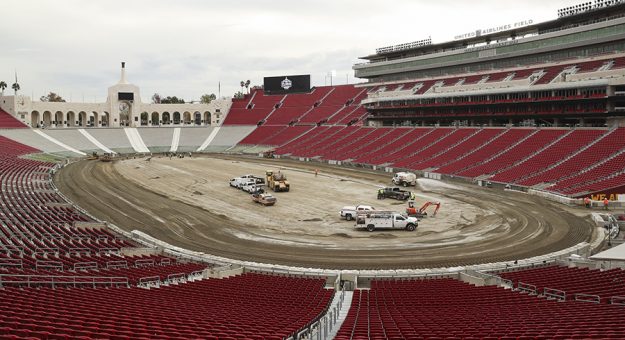WILMETTE, Ill. — As the new season begins, motorsports leaders continue to pursue opportunities to attract new fans and showcase the sport in various fashions.
This month, we examine these initiatives and the economics behind them.
NASCAR pivoted on many fronts during the pandemic, including shaking up the schedule. Officials chose to visit new tracks, transform existing venues and utilize creative race formats.
Last fall, NASCAR officials announced they were moving the annual preseason exhibition race — the Clash — from Daytona Int’l Speedway to the West Coast. Long held on the superspeedway at The World Center of Racing, the event was run on Daytona’s infield road course last year.
This year’s Busch Light Clash was run at the Los Angeles Coliseum. This iconic multi-purpose stadium was finished in 1923, making it nearly 100 years old. At its peak, it had a seating capacity of 105,000 and currently seats 77,500.
Home to the University of Southern California football team, it has hosted almost every activity conceivable. This includes the 1932 and 1984 Olympic Games and a Super Bowl.
Racing has a long history at the Coliseum. During the 1930s and ’40s, the stadium had varied surfaces — wood, dirt and paved ovals. In 1948, there were six races on the banked wood track with one attracting more than 55,000 spectators. Supercross was held there during the 1980s and Stadium Super Trucks raced there more recently.
There are many reasons NASCAR chose to move the Clash to California. One is the importance of the West Coast and the appeal of the Los Angeles market. It is the second-largest media market in the United States. The Super Bowl will be there the following week at the newly opened $5 billion SoFi Stadium in Inglewood.
A long list of celebrities and athletes attended The Clash, bringing visibility to the race.
For many years, NASCAR has maintained an office in Hollywood to be a part of the entertainment industry. The presence has been a successful business venture resulting in famous movies — “Days of Thunder,” “Talladega Nights” and the iconic “Cars” franchise.
In addition, there have been many movie promotions where teams have carried sponsorship for upcoming releases.
Sports in general can find Southern California to be a challenging marketplace. The area’s large size and traffic makes driving to events time consuming. There is also plenty of competition for the entertainment dollar.
Auto Club Speedway opened as California Speedway in 1997. The two-mile oval was built by Roger Penske on the site of a former steel mill. The track was planned to bring major league, professional racing back to Southern California after an absence of several decades.
It sold out its primary races for the first few years, but over time there has been a drastic decline in attendance at the track.
Construction on the quarter-mile race track inside the Coliseum began the week prior to Christmas. Crews had less then 50 days to complete the work before the green flag waved.
New Valley Construction of Phoenix, Ariz., is the general contractor that oversaw the build. They have prior experience working with NASCAR at Phoenix Raceway.
After the race, the track was torn up and the facility returned to its original condition. Cost estimates for the Clash at the Coliseum exceed $1 million.
There were layers of plastic and plywood over the field to protect it. It took 500 truckloads to lay the six-inch base layer of dirt. There were more than 1,500 tons of high-performance asphalt for the racing surface.
Safety was a major priority with the walls and catch fencing erected to the highest standards.
Working with special-purpose temporary venues has become more common in recent years.
The offseason international Race of Champions has been run at soccer stadiums around the world. A specific rally-type course is built, raced on and deconstructed each year.
The Monster Energy AMA Supercross Series constructs a new track every week as it moves around the country. It is constructed, removed and stored off-site until the next year. Dirt has been laid down at Bristol (Tenn.) Motor Speedway and refined each year, resulting in better racing.
A similar process is used annually to cover New York’s Oswego Speedway with dirt to host Super DIRT Week.
The business of temporary tracks is not inexpensive. Timelines are short, physical constraints are numerous and bottlenecks occur.
The goal is to provide a memorable racing experience that everyone can enjoy, while making fans and stakeholder partners want to return to these venues.
